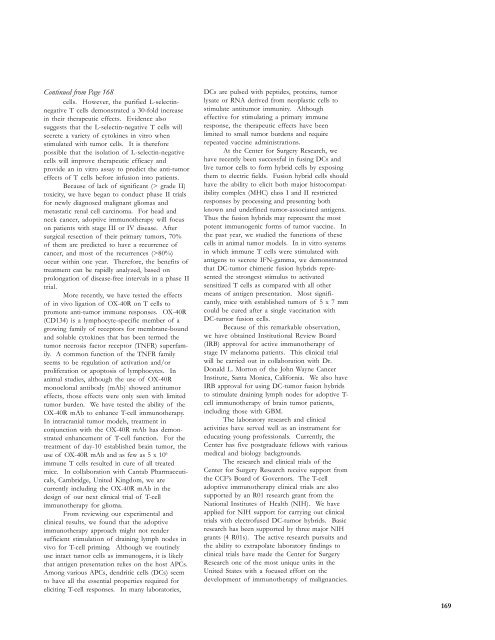Scientific Report 2003-2004 - Cleveland Clinic Lerner Research ...
Scientific Report 2003-2004 - Cleveland Clinic Lerner Research ...
Scientific Report 2003-2004 - Cleveland Clinic Lerner Research ...
- No tags were found...
Create successful ePaper yourself
Turn your PDF publications into a flip-book with our unique Google optimized e-Paper software.
Continued from Page 168cells. However, the purified L-selectinnegativeT cells demonstrated a 30-fold increasein their therapeutic effects. Evidence alsosuggests that the L-selectin-negative T cells willsecrete a variety of cytokines in vitro whenstimulated with tumor cells. It is thereforepossible that the isolation of L-selectin-negativecells will improve therapeutic efficacy andprovide an in vitro assay to predict the anti-tumoreffects of T cells before infusion into patients.Because of lack of significant (> grade II)toxicity, we have began to conduct phase II trialsfor newly diagnosed malignant gliomas andmetastatic renal cell carcinoma. For head andneck cancer, adoptive immunotherapy will focuson patients with stage III or IV disease. Aftersurgical resection of their primary tumors, 70%of them are predicted to have a recurrence ofcancer, and most of the recurrences (>80%)occur within one year. Therefore, the benefits oftreatment can be rapidly analyzed, based onprolongation of disease-free intervals in a phase IItrial.More recently, we have tested the effectsof in vivo ligation of OX-40R on T cells topromote anti-tumor immune responses. OX-40R(CD134) is a lymphocyte-specific member of agrowing family of receptors for membrane-boundand soluble cytokines that has been termed thetumor necrosis factor receptor (TNFR) superfamily.A common function of the TNFR familyseems to be regulation of activation and/orproliferation or apoptosis of lymphocytes. Inanimal studies, although the use of OX-40Rmonoclonal antibody (mAb) showed antitumoreffects, those effects were only seen with limitedtumor burden. We have tested the ability of theOX-40R mAb to enhance T-cell immunotherapy.In intracranial tumor models, treatment inconjunction with the OX-40R mAb has demonstratedenhancement of T-cell function. For thetreatment of day-10 established brain tumor, theuse of OX-40R mAb and as few as 5 x 10 6immune T cells resulted in cure of all treatedmice. In collaboration with Cantab Pharmaceuticals,Cambridge, United Kingdom, we arecurrently including the OX-40R mAb in thedesign of our next clinical trial of T-cellimmunotherapy for glioma.From reviewing our experimental andclinical results, we found that the adoptiveimmunotherapy approach might not rendersufficient stimulation of draining lymph nodes invivo for T-cell priming. Although we routinelyuse intact tumor cells as immunogens, it is likelythat antigen presentation relies on the host APCs.Among various APCs, dendritic cells (DCs) seemto have all the essential properties required foreliciting T-cell responses. In many laboratories,DCs are pulsed with peptides, proteins, tumorlysate or RNA derived from neoplastic cells tostimulate antitumor immunity. Althougheffective for stimulating a primary immuneresponse, the therapeutic effects have beenlimited to small tumor burdens and requirerepeated vaccine administrations.At the Center for Surgery <strong>Research</strong>, wehave recently been successful in fusing DCs andlive tumor cells to form hybrid cells by exposingthem to electric fields. Fusion hybrid cells shouldhave the ability to elicit both major histocompatibilitycomplex (MHC) class I and II restrictedresponses by processing and presenting bothknown and undefined tumor-associated antigens.Thus the fusion hybrids may represent the mostpotent immunogenic forms of tumor vaccine. Inthe past year, we studied the functions of thesecells in animal tumor models. In in vitro systemsin which immune T cells were stimulated withantigens to secrete IFN-gamma, we demonstratedthat DC-tumor chimeric fusion hybrids representedthe strongest stimulus to activatedsensitized T cells as compared with all othermeans of antigen presentation. Most significantly,mice with established tumors of 5 x 7 mmcould be cured after a single vaccination withDC-tumor fusion cells.Because of this remarkable observation,we have obtained Institutional Review Board(IRB) approval for active immunotherapy ofstage IV melanoma patients. This clinical trialwill be carried out in collaboration with Dr.Donald L. Morton of the John Wayne CancerInstitute, Santa Monica, California. We also haveIRB approval for using DC-tumor fusion hybridsto stimulate draining lymph nodes for adoptive T-cell immunotherapy of brain tumor patients,including those with GBM.The laboratory research and clinicalactivities have served well as an instrument foreducating young professionals. Currently, theCenter has five postgraduate fellows with variousmedical and biology backgrounds.The research and clinical trials of theCenter for Surgery <strong>Research</strong> receive support fromthe CCF’s Board of Governors. The T-celladoptive immunotherapy clinical trials are alsosupported by an R01 research grant from theNational Institutes of Health (NIH). We haveapplied for NIH support for carrying out clinicaltrials with electrofused DC-tumor hybrids. Basicresearch has been supported by three major NIHgrants (4 R01s). The active research pursuits andthe ability to extrapolate laboratory findings toclinical trials have made the Center for Surgery<strong>Research</strong> one of the most unique units in theUnited States with a focused effort on thedevelopment of immunotherapy of malignancies.169
















